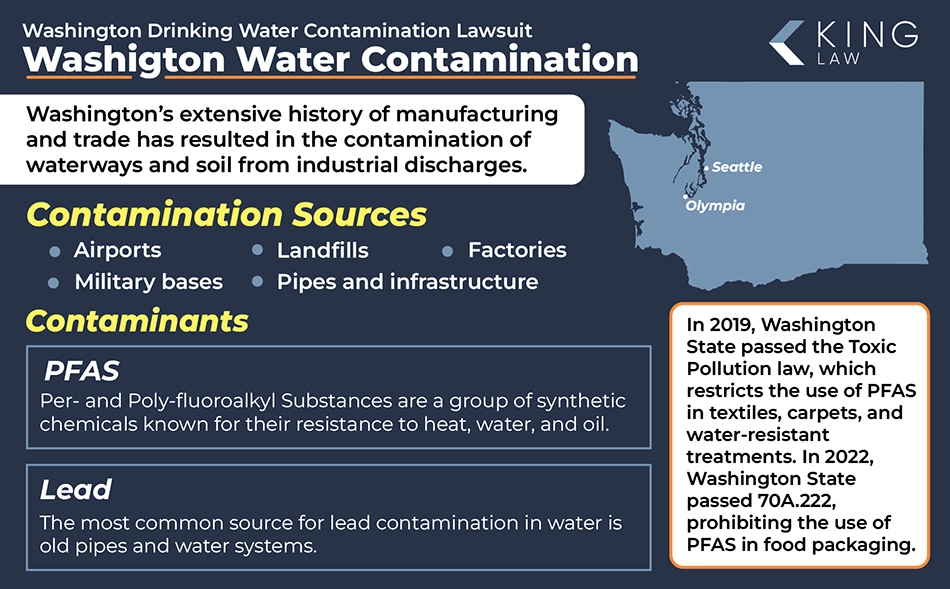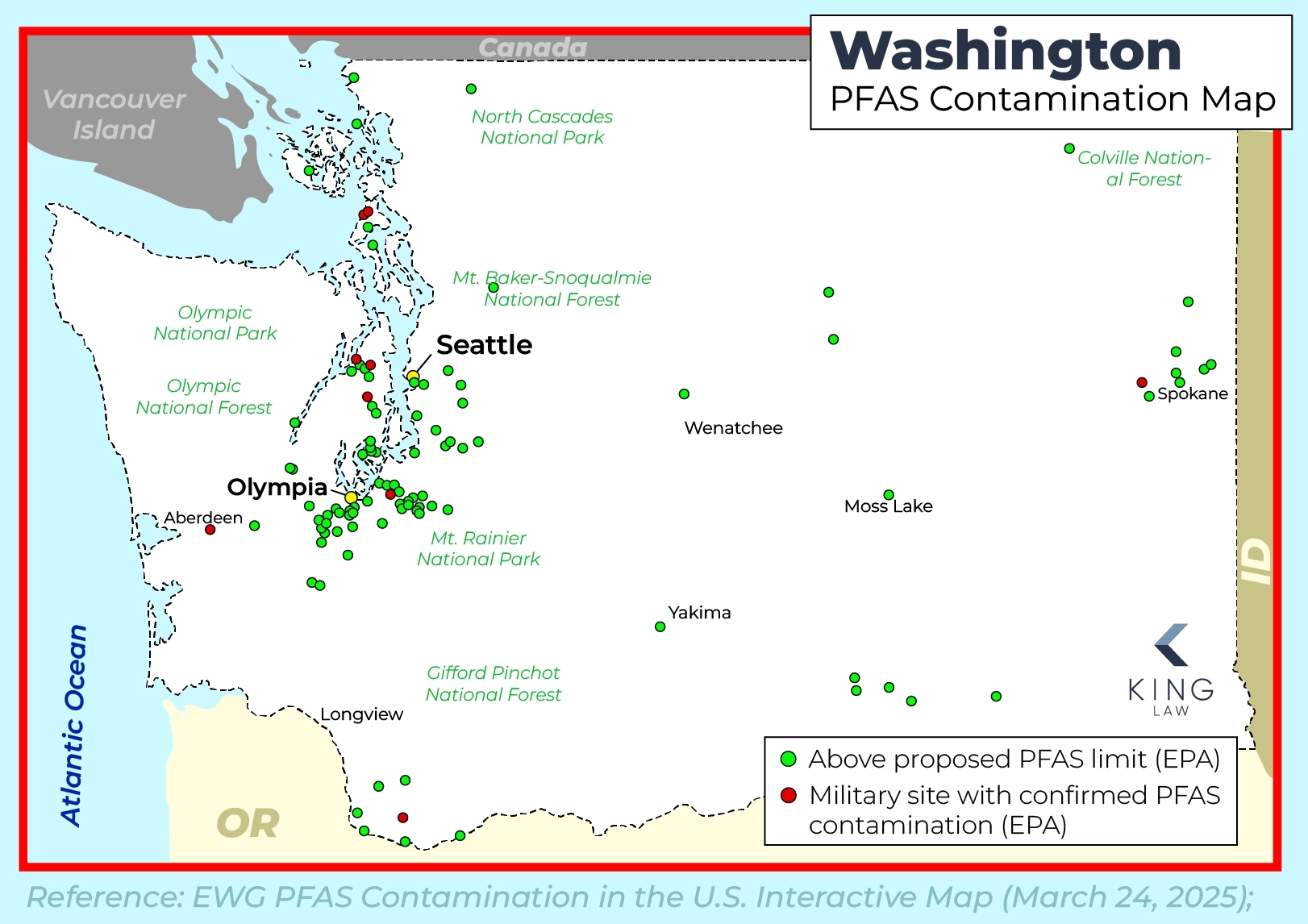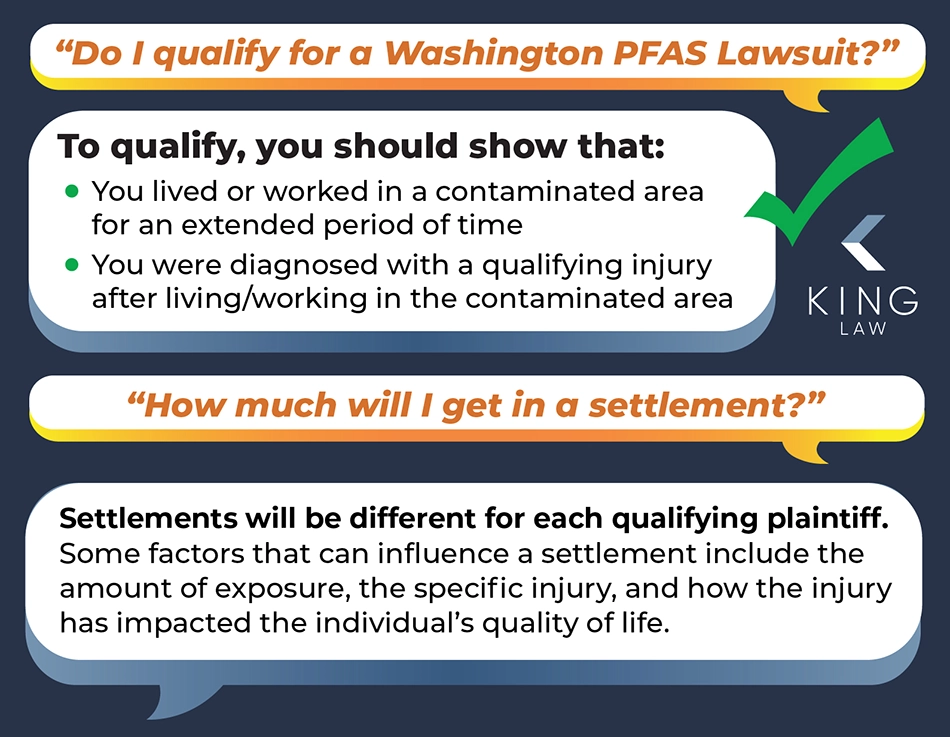
Washington has a lot of beautiful rivers and scenery, but like most of the country, the state also has water contamination. Specifically, many of Washington’s waters are contaminated with PFAS, a group of chemicals known as “forever chemicals.” PFAS have numerous negative impacts on human health. Many people who were exposed to contaminated drinking water have filed lawsuits after developing cancer and other conditions.
PFAS is the main component of a firefighting foam called AFFF, which were used on military bases and airports across Washington state. What makes PFAS chemicals significant is they do not break down. It takes a lot of resources to dispose of the chemicals properly, and humans and animals cannot process them if they are consumed. Exposure to PFAS can cause injuries such as kidney cancer, testicular cancer, thyroid conditions, and ulcerative colitis.
Washington residents are filing lawsuits against the companies responsible for the water contamination that led to their injuries in order to receive compensation.
Washington Water Contamination Lawsuit Overview
Washington has a long history of shipping, manufacturing, and trade. Industrialization and modernization have resulted in contaminants being released into waterways and soil. This has led to many drinking water supplies being contaminated with toxic chemicals.
Washington, the only state named after a president, was granted statehood in 1889. Three years prior, in 1883, the Northern Pacific Railroad was completed and ran from St. Paul, Minnesota, to Tacoma, Washington. The Northwest became accessible, causing its population and economy to rise. Due to its coastal ports, Washington quickly became the leader in trade with Alaska, Canada, and countries of the Pacific Rim, such as Mexico.
The rise of urbanization and industrialization in Washington has also led to increased environmental contaminants, such as lead and PFAS. PFAS, short for per- and polyfluoroalkyl Substances, can lead to serious health risks when consumed. A primary concern is contaminated groundwater. In 2021, the Washington State Board of Health adopted State Action Levels for PFAS chemicals to protect public health.
Officials in Washington are aware of the serious health effects PFAS can cause and are working to clean up all traces of it. For example, Seattle-Tacoma Airport is the first airport in the country to be utterly free of AFFF Foam, and they even contracted a team to help them dispose of all chemical residue.
Timeline of Water Contamination in Washington | 2025 Update
August 2010: State of Washington Department of Ecology publishes a study to show PFAS in the environment
Washington’s Department of Ecology began its search for a baseline of PFAS in the environment in 2008. Two years later, Ecology reported that every lake and river tested showed traces of PFAS, with higher levels in urban waters. Bioaccumulation, the accumulation of chemicals from prey to predator, was also examined. Sixty-seven percent of the sampled fish had PFOS detected in their livers, and all 11 tested osprey eggs contained PFAS at levels higher than those found in fish, indicating the chemicals were bioaccumulating up the food chain.
October 2015: The City of Issaquah found PFAS contamination in a water supply well
Issaquah, Washington, hired experts to test levels of PFAS in their drinking water wells and found one contained high levels of the forever chemicals. The city quickly turned off the well and put in an activated carbon filtration system to reduce PFAS. They began to test all drinking water frequently, and the City of Issaquah Water Service Area continuously met safe drinking water levels until 2020, when another well was shown to be contaminated. To combat this and all future contamination, Issaquah successfully injected colloidal activated carbon into the ground to trap PFAS.
2016: Washington’s Department of Ecology conducts another statewide survey to compare results from a previous PFAS study
Samples of fresh water, fish tissue, and osprey eggs were tested for PFAS to detect how levels have changed since 2008. There was no significant increase or decrease of the chemical in the fish or osprey eggs; however, surface water samples collected from the same sites as the first study showed less PFAS detected than in 2008.
2018: Washington bans PFAS in paper food packaging and in AFFF Foam
Washington State passed the Firefighting Agents and Equipment Law, which prohibits the manufacturing, selling, and use of AFFF foam. Firefighting personal protective equipment that contain PFAS, such as helmets, gloves, and respiratory equipment, can still be made and sold, but a written notice must be supplied to all consumers that the products contain PFAS. Due to this new law, the state realizes this will leave fire departments with excess AFFF that cannot be used. The Department of Ecology started the AFFF collection and disposal program to offer a free, safe disposal option.
April 2024: The Environmental Protection Agency published the final human health toxicity assessment for PFOA
The EPA completed 780 human and animal health studies and determined PFOA oral exposure can lead to severe injuries, such as kidney cancer and testicular cancer. Other issues, such as low infant birth weight and liver damage, were also connected to PFOA exposure in humans. Understanding the chemicals’ effects on the human body is important in determining safe exposure levels. On April 10, 2024, the EPA established legally enforceable Maximum Contaminant Levels for PFAS in drinking water.
About the Washington Water Contamination Lawsuit:
Sources of Water Contamination in Washington
Washington’s Regulations for Drinking Water
Contaminants Found in Washington Drinking Water
Current Water Quality in Washington
Health Risks and Symptoms Linked to Drinking Water in Washington
Eligibility Criteria for the Washington Water Contamination Lawsuit
Washington Water Contamination Settlement and Payout Amounts
How to File a Washington Water Contamination Lawsuit
Statute of Limitations for Washington Water Contamination Claims
Sources of Water Contamination in Washington
One of the largest sources of PFAS is aqueous film-forming foam, which is known as AFFF. These foams are classified as a class B firefighting foam. AFFF has been used to control fuel-based fires on military bases and airports since the early 1970s. The foam is made with PFAS . As the product was applied and cleared by firefighting personnel, PFAS managed to enter the groundwater and drinking water on and near military bases or airports. This contamination has led to many people developing diseases related to their exposure. The AFFF Foam Litigation was filed in court in April of 2024 and brings attention to the contamination caused by this product across the country.
Washington airports with confirmed high PFAS contamination include:
Washington Military Bases with confirmed high PFAS contamination include:
- Naval Air Station Whidbey Island: Off-base drinking water (2016) 3,823 ppt for PFOA+PFOS, On-Base drinking water (2018) 25,900 ppt for PFOS
- Fairchild Air Force Base (2019): 167,000 ppt for PFOA+PFOS
- Camp Bonneville (2023): 31 ppt for PFBA and 4.9ppt for PFOA
- Joint Base Lewis-McChord (2018): 29,400 ppt for PFOA+PFOS
- Joint Base Lewis McChord- Yakima Training Center (2020): 100 ppt for PFOA+PFOS
- Puget Sound WA Naval Shipyard (2022): 2,160 ppt for PFOS and 665 ppt for PFOA
- NUWC Division Keyport (2020): 77ppt for PFOA+PFOS
- Naval Base Kitsap-Bangor: Private wells off-base (2020) 178 ppt for PFOA+PFOS, On-base drinking water (2022) 1,140 ppt for PFOA and 5,880 ppt for PFOS
Drinking water at or near military installations has tested positive for unsafe levels of PFAS. For example, Ft. Lewis McChord and Fairchild Air Force Base have been known to have PFAS water contamination at levels that risk public health.

Washington’s Water Contamination Map
We created a Washington water contamination map to visualize the widespread PFAS contamination in the state. Most locations are on or near locations that consistently used AFFF foam, such as Whidbey Island and Ft. Lewis-McChord. The EPA’s legal limit for PFAS in the water supply is 4 ppt, and the AFFF foam entering the water has significantly raised this value.

Washington’s Regulations for Drinking Water
Washington State is actively trying to remediate PFAS contamination and ban products that contain the chemicals. All water systems in the state that serve 25 or more people must be sampled for PFAS by December 21, 2025. Cities like Bellingham are ahead of the game by consistently testing their drinking water. In 2022, the city did voluntary PFAS testing, and none were detected. In 2024, Bellingham started sampling for UCMR 5, which includes an analysis of 29 different PFAS substances, and the results are mailed to all consumers in the area annually.
Seattle is another city working to be PFAS-free, with the Port of Seattle Fire Department leading the way. The fire department has voiced its concern over the local contamination and found ways to remove PFAS substances efficiently. The Port of Seattle was also heard nationally, fighting for the Federal Aviation Administration (FAA) to publish a transition plan to discontinue using AFFF Foam and other PFAS substances across the country. The plan was published in May 2023; before this, the FAA required airports nationwide to use AFFF foam. Now, Seattle-Tacoma International Airport is the first airport in the country to remove PFAS thoroughly from airport fire trucks. By the autumn of 2025, all 11 of Washington’s commercial airports will be PFAS-free.
Contaminants Found in Washington Drinking Water
In recent years, some of the most concerning chemicals in Washington’s drinking water are PFAS and lead. PFAS are a concern in Washington’s drinking water because of the risks to public health and the persistence of these products in the environment. The term PFAS is shortened for per- and polyfluoroalkyl substances and refers to chemicals such as PPFOA, PFOS, PFNA, and PFBA, all found in Washington’s drinking water. Industrial pollution has also caused other contaminants in Washington’s drinking, such as copper and lead.
Per- and Polyfluoroalkyl Substances (PFAS)
Ground contamination is the main way PFAS enter drinking water. These chemicals are found in AFFF foams. These foams are class B foam used by airports and military bases. After the foam product is used, the foam gets washed away. When this product is cleared, PFAS can enter the soil and end up in water supplies. This chemical is nicknamed a “forever chemical” because it does not naturally break down, allowing it to invade the environment and cause health risks to humans. PFAS exposure can be linked to various health concerns, such as thyroid disease, kidney cancer, testicular cancer, and ulcerative colitis.
PFAS water contamination is a concern throughout the state of Washington. Unsafe levels of these chemicals are linked to:
- Birth defects
- Bladder cancer
- Breast cancer
- Changes in liver enzymes
- Decreased vaccine effectiveness
- Hodgkin’s and non-Hodgkin’s lymphoma
- Leukemia
- Lowered immune response
- Multiple-myeloma
- Kidney cancer*
- Liver cancer*
- Pancreatic cancer
- Prostate cancer
- Reproductive issues
- Testicular cancer*
- Thyroid cancer*
- Thyroid disease*
- Ulcerative colitis*
*Represents condition our firm is accepting cases for
Lead
The most common lead source in the water supply is water distribution lines or household plumbing. Soft water, brass fixtures, or lead connectors, can cause lead to leach out of old pipes and be present in drinking water. In 2016, the governor of Washington instructed the Washington State Department of Health to lead a directive in locating all potential sources of lead and find ways to lower exposure. Of the 686 water systems that serve 2.2 million residents, 0.04% have lead connectors in the service lines. This is much less than the national average estimate. Washington State continues to execute safe practices such as collecting resident’s water samples and treating the water when more than 10% of samples exceed the action level.
Current Water Quality in Washington
As of April 21, 2023, the Washington State Department of Health has recommended residents of the west side of San Juan Island and southwest of Friday Harbor purchase bottled water for drinking and cooking due to the detection of PFOS and PFOA above the EPA’s health advisory level.
The EPA sampled 411 private wells in the West Plains of Spokane, Washington, in March and June of 2024. PFAS over the safe drinking water standards was found in 57% of these wells. Washington’s Department of Ecology provides bottled water at the resident’s request. Meanwhile, the department has awarded the City of Medical Lake a grant to conduct an area-wide groundwater investigation to create a PFAS contamination model for the groundwater in the West Plains.
Water Treatment Efforts in Washington
Since PFAS can end up in water supplies by way of various products, multiple steps must be taken to ensure those products are banned from the state. Washington State passed the Toxic Pollution Law in 2019, which restricts the use of PFAS in textiles, carpets, and water-resistant treatments. Additionally, effective January 1, 2022, all use of PFAS in food packaging has been prohibited under Washington State Law 70A.222. This law was passed 2 years before the FDA passed a federal mandate to phase out PFAS products in food packaging. These efforts are to ensure PFAS will cause less harm to public health.
Health Risks and Symptoms Linked to Drinking Water in Washington
The most studied PFAS chemical, PFAO, was labeled as a human carcinogen in 2023. Since then, there has been a correlation with high levels of exposure to types of PFAS and cancers such as kidney and testicular cancer. A 2023 study published in the National Library of Medicine observed the link between servicemen who were exposed to PFAS through either firefighting or drinking water on bases and testicular cancer. It was found that elevated amounts of PFOS in the blood can be associated with higher risks of developing testicular cancer. The study was deemed to warrant further investigations into PFOS risk and contaminated areas. Although it is very rare, testicular cancer is the most common type of cancer found in men between 20 and 39 years old.
PFAS have been found in the drinking water on Fairchild Air Force Base in Spokane, Washington, and exposure can lead to harmful effects. It is encouraged for individuals who have spent more than 6 months on Fairchild Air Force base to keep up regular physicals with their doctor and do self-exams monthly to watch for any potential harmful effects.
PFAS Exposure Linked to Various Health Conditions:
- Kidney cancer
- Testicular cancer
- Thyroid cancer
- Thyroid disease
- Ulcerative colitis
- Bladder cancer
- Non-Hodgkin’s lymphoma
- Hodgkin’s lymphoma
- Leukemia
- Male breast cancer
- Prostate cancer
- Liver cancer
Eligibility Criteria for the Washington Water Contamination Lawsuit
There are specific criteria used to determine eligibility for a Washington state water contamination lawsuit. These criteria can include:
- Time of Exposure: A combined time of at least 1 month spent either living or working at an identified contaminated area.
- Specific Diagnosis: Our firm is reviewing cases with a diagnosis of:
- Supporting Documents: Necessary documentation includes proof of diagnosis and proof of residence or employment during the contamination period.
These considerations are crucial to laying the groundwork for a sturdy legal claim. By starting the process and consulting with expert attorneys, you are taking the first step toward possible compensation. The experienced attorneys at King Law are here to help guide you through eligibility. If you are unsure about eligibility, our team will work through the details with you.

Washington Water Contamination Settlement and Payout Amounts
A few factors will be examined when determining compensation amounts for Washington water contamination lawsuits. These factors can include the amount of exposure. For example, individuals who spend extended time on known exposure sites may receive higher payouts. Another component is documentation of injuries linked to exposure and how the injury has affected someone’s quality of life.
Depending on exposure and diagnosis, the settlement amount may be between $30,000 and $300,000. It is important to note these litigations take time, and it may take a few months to over a year before progress toward compensation is made. A lawyer can help set up a realistic time frame for your case. Receiving a free consultation with an attorney about your potential Washington water contamination lawsuit can give you a better understanding of how you may be compensated.
How to File a Washington Water Contamination Lawsuit
A free consultation with an attorney’s office is the first step in the process of filing your Washington water contamination claim. King Law’s in-house intake team will be able to determine your eligibility and discuss what to expect after initially filing your claim.
Factors examined when determining eligibility include your state’s statute of limitations and your ability to provide evidence such as medical records.
Evidence to Support Your Washington Water Contamination Claim
To substantiate your claim, it is crucial to gather evidence that shows you were exposed to contaminated water and that this exposure led to your diagnosis. This evidence can include:
- Medical records: Proof of diagnosis and treatments
- Documentation showing residence or employment: Employment records, utility bills, or lease agreements
- A copy of military orders: An official list of military bases stationed with dates
- Environmental Studies: Reports revealing the levels of PFAS contamination in the area’s water supply
Statute of Limitations for Washington Water Contamination Claims
The statute of limitations is an essential factor to consider when pursuing a Washington water contamination lawsuit. A statute of limitations is a legal timeline that individuals must file lawsuits within to be eligible for compensation. In Washington, the statute of limitations for personal injury claims, including those related to toxic exposure, is three years from the date of diagnosis.
However, the deadlines for filing a claim can vary depending on each individual case and the circumstances surrounding it. Urgently discussing your potential case with a lawyer can increase your chance of avoiding statute of limitation issues and receiving compensation. If you only recently learned your diagnosis might have been due to contaminated drinking water, you may still be able to file a lawsuit.
Washington Water Contamination Lawyers
The attorneys at King Law are knowledgeable in Washington water contamination lawsuits, including claims that involve military bases such as Fairchild Airforce Base, Fort Lewis-McChord, and Whidbey Island. Our team has specific experience with PFAS contamination lawsuits, and we understand the environmental and health risks of the chemicals. An experienced personal injury attorney’s legal guidance can ensure your case is as successful as possible.
King Law provides a range of legal support, including skilled representatives, complimentary claim assessments, and legal advocacy. The attorneys at King Law Firm possess significant experience and in-depth expertise in environmental and personal injury litigation, helping to enhance your chances of success in these cases.
Frequently Asked Questions (FAQs)
Learn more about water contamination in Washington with answers to these frequently asked questions:

